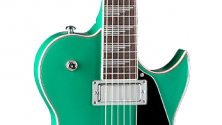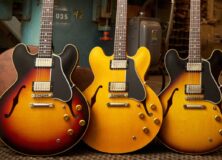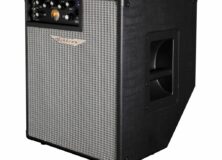
Read Time 2 Minutes

Since the original Jem models were covered just the other day it seems reasonable to conclude with what the Jems have adapted into. The Jem originated in 1987, but it wasn’t until 1993 that it saw the makeover that set the precedence for most modern Jems as we know them. In fact, when the JEM7 line was introduced only one original model, the Desert Sun Yellow 777, was still in production, and that only had a few years left to its lifespan by then.
As legend has it Vai had consulted Ibanez (if you can imagine that) on developing the new model. Keeping a long story short they developed three models primarily differentiated by their pickups. The one he landed on was armed and dangerous with a set of DiMarzio Evolution pickups which was given the nickname Evo. Since then it’s hardly been a secret that Evo has been Vai’s favorite and primary guitar, having been used on every album and tour since, and the line of JEM7 guitars to ensue would be based entirely off that one specific git-box.
Evo has not had any outlandish modifications differentiating it from any other Jem available, though Evo in specific has been through three or four different necks from a number of mishaps, the strap pegs have literally ripped out of the body, and the guitar now has a vicious crack running down the back side. Talk about a guitar that’s been there and done that. The guitar is built of alder and the neck is made of maple and walnut, and the rosewood fretboard has been scalloped on the 21-24th frets to make fretting and bending higher up easier.
The guitar comes stock with the DiMarzio Evolution pickups that started it all and an Edge Pro bridge for anyone who cares to be as eccentric as Mr. Vai with a whammy bar. The looks are topped off with classy, gold hardware, pearl/abalone vine inlays and a tastefully placed handlebar in case you left your case at home when you went out on tour.
Most JEM7 guitars produced since share very similar designs, and the Evolution pickups being the defining trait relative to all models, though there have been a few models during the initial development and since the first production that retained the original basswood body and at some point ebony was a candidate for the fretboard wood before settling on the now common rosewood. Other minor differences include varying paint finishes and some differing inlays.
The JEM77 line was developed more or less along the same time frame and naturally shares a great deal of similarities to the JEM7 line, though the 77 line has been consistently built out of basswood. The standard pickups for the JEM77 have varied depending on the era the given guitar was developed in. Originally they used DiMarzio PAF Pro pickups, but later adopted DiMarzio Breed pickups instead. Much like the JEM7 other details include varying finishes and inlays, most famously being the MOJO guitar’s blue LED inlays.






Very good write-up. I definitely love this website. Stick with it!